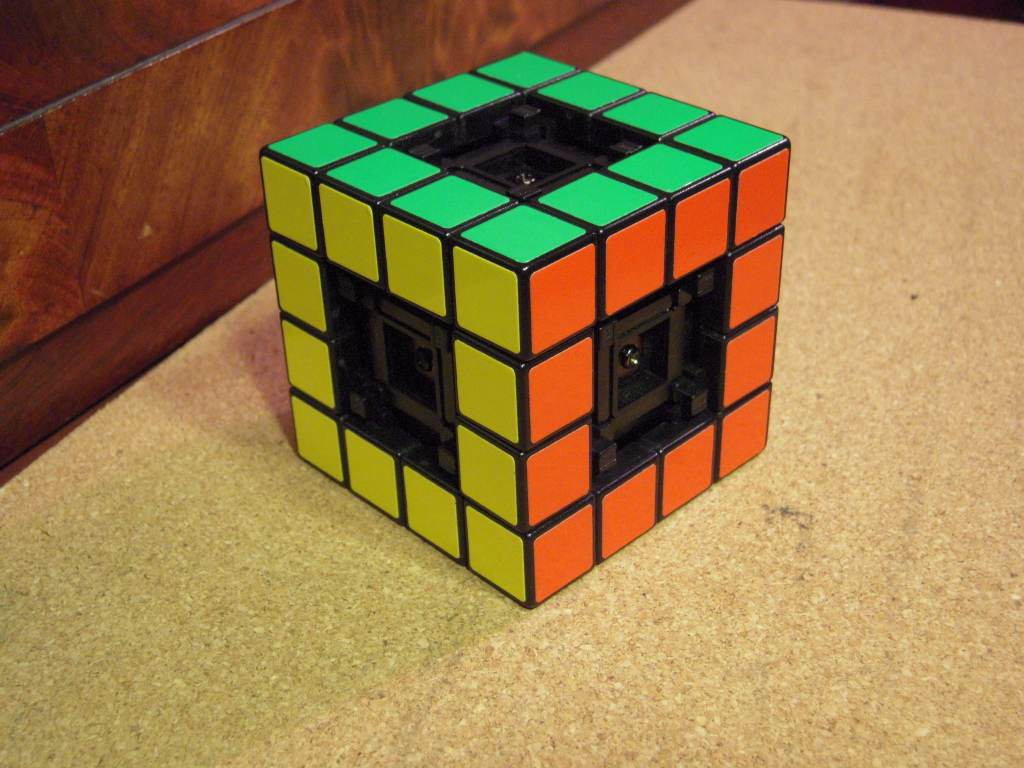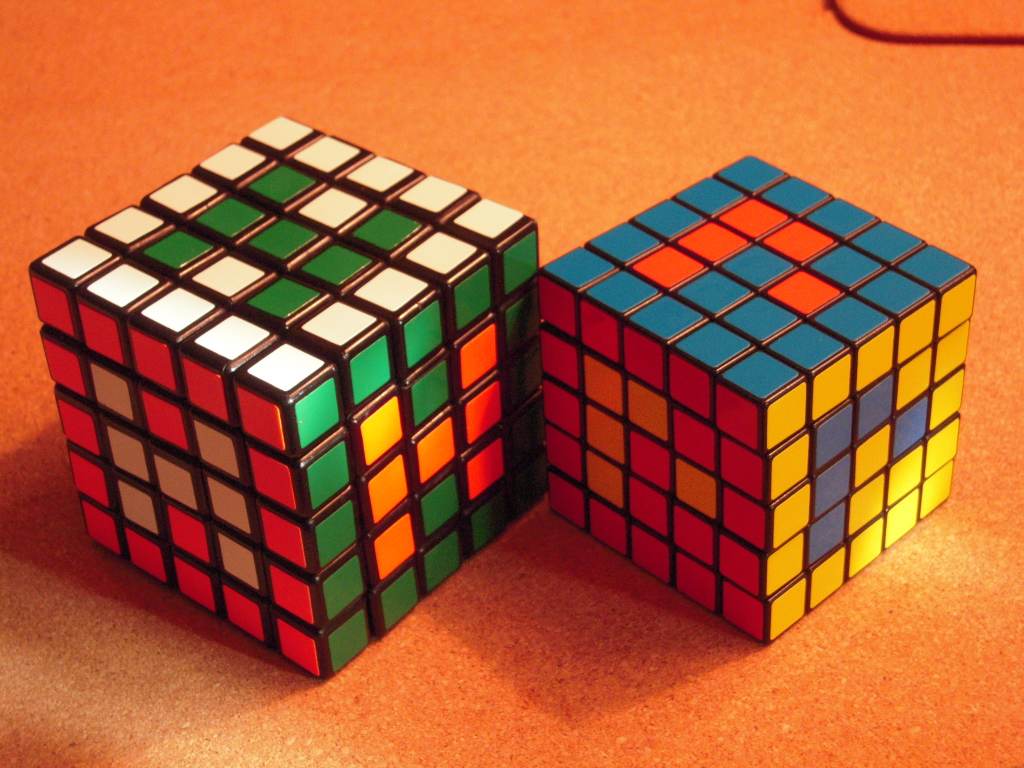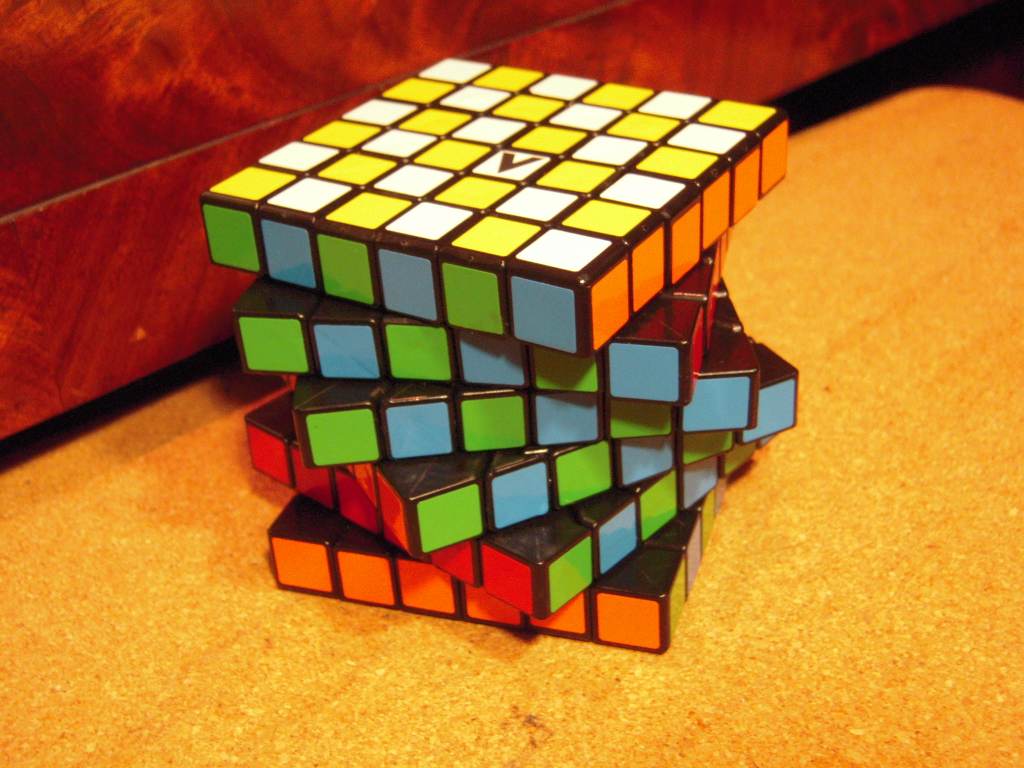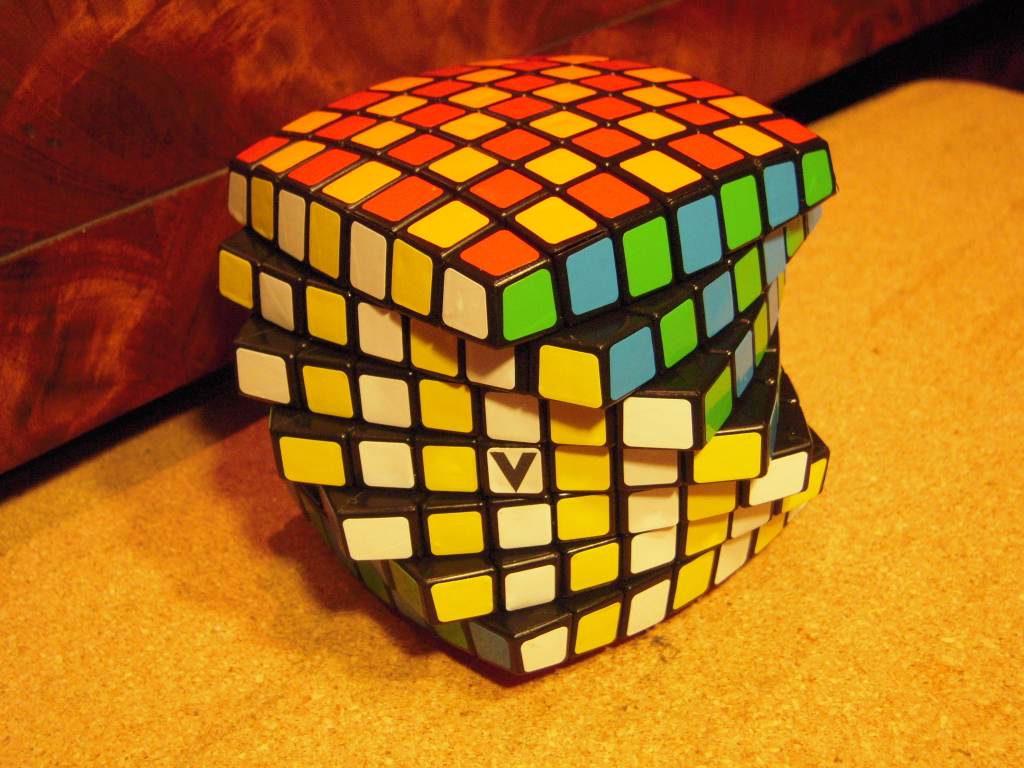First page . . . Back to page 5
Centerless 4×4×4
This is the 4×4×4 equivalent of the "Void Cube". There is no actual puzzle like this, but it can be approximated quite well by an Eastsheen 4×4×4 with the center caps removed (a harmless, easily reversed modification):

The void 4×4×4 emulated by an Eastsheen 4×4×4
If you have a Rubik's 4×4×4 you can hide the center facelets with black stickers.
When solving the centerless 4×4×4, there are two major simplifications as compared to a normal 4×4×4 solve:
- Naturally because there are no centers, shorter algorithms can be used for dedge pairing because centers do not need to be preserved.
- If a 3×3×3 reduction step is used, a swapped pair of dedges might be left at the end, just as a swapped pair sometimes results on the Void cube. However, on the void 4×4×4 this pair can be swapped much more easily.
4×4×5
Here are several videos showing a 4×4×5 in action: Tony Fisher, neochronius, traiphumi. The most effective technique for creating this puzzle is based on Eastsheen 4×4×4 components; see here.
here are some photos.
4×4×6
Tony Fisher built one, and its motion can be seen in this video. The behavior of the eight corner pieces suggests that the design is a heavily modified 4×4×4 with custom-made pieces on the 1st and 6th layers.
5×5×5
For about 20 years this was the largest cube size available.

Rubik and Eastsheen 5×5×5 Cubes
With 9 center facelets on each side, arbitrary patterns can be created quite easily, as seen in the photo. See my video tutorial on pattern-weaving.
Solution: My 5×5×5 technique is similar to that for the 4×4×4.
1. Create a reference center by getting about 6 or 7 of the same color center pieces onto one face. Make sure the central center is one of this matched group.
2. Bring matching edges together into tredges.
2a. I create one tredge at a time and store them on the U and D layers, just as in my 4×4×4 technique. Sometimes a 9th can be created out of what remains on the equator.
2b. Unify outer edges, without trying to match them with center edges yet. I use the following algorithms, adapted from the 4×4×4:
Place two outer edges to be fixed in the UL and UR positions. The outer edge at ULB should match the one at URF. If the three edges at UR are oriented the wrong way for this to work, flip it over with something like R'UF'U'.
To exchange ULF with URF, use R2F2 R2F2' R2 (5s).
2c. Move center edges to join them with their corresponding pairs of outer edges. I use the same edge-movement algorithms as on the 3×3×3, suitably rewritten:
To cycle (UF, FR, FL), use R3F R3'F2 R3F R3' (7s)
To flip UF and UB, use (R3U)2 R3U2 (R3'U)2 R3'U2 (12s)
2d. Flip outer edges to match their center edges. This is done with a dual pair swap that is equivalent to the UF and UB flip from the 3×3×3 but leaving the central edge alone. To swap (UFL, UFR) and (UBL, UBR), use (R24U)2 R24U2 (R24'U)2 R24'U2 (16s)
2e. There may be one tredge left that is flipped the wrong way. This is fixed by swapping the two outer edges of that tredge. To swap the outer edges at FRD and FRU, the optimal algorithm is exactly the same as on the 4×4×4: D2'R2D2R2 U2'R2U22 F2D2F2U2' R2F2D22F2 (15s)
3. Solve like a 3×3×3 (ignoring the centers). Use the void cube method. Because there is no reference for the centers, you may get a single swapped edge pair (or corner pair, if you solve the corners last), just as on the Void cube.
3a. Since this is an odd-numbered cube, you can avoid the edge swap issue by taking note of the central centers during your 3×3×3 emulated solve. This usually consists of doing the first layer, then turning it to match the central centers, before proceeding to the middle and last layers.
4. Fix edge "parity". On the 5×5×5, the 4×4×4 UR-DR exchange will not work, so you have to use the Void cube technique of doing a 90o central slice turn (on the 5×5×5, this is R234, F234, etc.) and then using 3-cycle algorithms to put the edges back where they belong.
Because the 5×5×5 has center edges and the tredges have been matched, there will not be a need for a single edge flip as there is on the 4×4×4.
5. Solve the centers. I use the same commutator techniques as described in my 4×4×4 technique.
More Algorithms: As the cubes get larger, there is a greater selection of commutators for centers, and assorted other special combinations of piece types.
To 3-cycle (UR → LU → FR), use DR2D' F3 DR2'D' F3' (8s).
5×5×6
Tony Fisher has made one, shown here with video here.
6×6×6

The V-CUBE 6
This puzzle is the first widely available 6×6×6 design. It accomplishes this in a cube shape by using slightly wider layers for the 1st and 6th layers in each dimension. The difference is usually not noticed until it is pointed out.
The existence of a 6×6×6 cube allows us to directly emulate all smaller puzzles with dimensions up to 6 in any dimension — prior to the 6×6×6, emulation could only be done for puzzles that went up to 4 in each direction, plus a few all-odd cases like the 3×3×5.
See my patternweaving tutorial for large cube patterns.
7×7×7

The V-CUBE 7
This puzzle is the first widely available 7×7×7 design. It uses a slight curved or "pillowed" shape to enable the internal circular tracks to clear the corner pieces at the extreme point (45o) of each turn.
Along with the 6×6×6, the 7×7×7 allows emulation of much larger cuboid shapes. Using the blacked-out center technique (as shown in the 2×2×3 and 2×3×3 sections, for example) any combination of up to 7 layers in each direction can be emulated. In addition, cuboids with odd dimensions on all three axes (such as a 3×5×7) can be emulated directly.
The 7×7×7 also provides the largest "canvas" for pattern-drawing. The image at the beginning of this article (see here) provides a modest example. Here is a video tutorial on the technique.
Three-layer Octahedron
Six corner pieces, 12 edge pieces, and 24 center pieces.
Every turn is a product of five 3-cycles, each of which is an even permutation of one of the three piece types. Therefore each piece type is always in an even permutation. However, the even/odd permutation distinction is not visible in the center pieces because there are 3 of each color.
The corner pieces have four possible orientations. The home orientation can be defined by two opposite colors (e.g. the purple and gray), and after doing this it is easy to see that the total rotation sums to 360o.
The edge pieces have two possible orientations. Place the puzzle on the table with one face flat; each corner now has one side that is higher off the table than the other side. Define the home orientation as the higher face of the three topmost and the three bottom-most edge pieces, and the lower face of the other six edge pieces. This labels the home orientation by four faces that share vertices only — for example (on my model), purple, yellow, green and orange. Using this labeling it is easy to see that edge orientation never changes — and in fact, no sticker ever shares a face with any sticker from the other set of 4 colors. This allows us to further restrict the rotation of corners: each can rotate into only 2 different positions.
Since all pieces move, there is no fixed orientation, so one corner piece can be assumed to be solved and used to define the orientation of the rest of the puzzle.
Therefore we have: 5!×25/2 for the corners; 12!/2 for the edges, and (12!/64)2 for the center pieces, or 31408133379194880000000 ≈ 3.1408×1022.
Cube Lubrication
I use CRC Heavy Duty Silicone, in a can, which includes the following ingredients:
Acetone (CAS registry number 67-64-1) : The primary ingredient in nail polish remover, superglue remover, and a wonderful solvent for nearly any type of plastic that cubes are made of. Once a little plastic has been dissolved, the resulting combination of acetone plus plastic makes a really good plastic cement. Its purpose in silicone spray is to wash away accumulated heavy grease, oil and any other "dirt" that has collected inside the equipment being lubricated.
Heptane (CAS registry number 142-82-5) : Another solvent, capable of removing rubber cement. Its purpose in silicone spray is similar to that of the acetone.
Dimethylpolysiloxane (CAS registry number 63148-62-9) : A nonvolatile lubricant, this is the actual "silicone" and the only component that remains for an extended period of time; it is the purpose of using the spray.
A mixture of Propane, Isobutane, and/or N-Butane (CAS registry number 68476-86-8) : Flammable gases with a relatively high condensation temperature, which therefore become liquid at fairly low pressure and are consequently useful as propellants.
Footnotes and Bibliography
[1] David Singmaster, Notes on Rubik's Magic Cube, (Enslow Publ., London) 1981. ISBN 0-89490-043-9 or 978-0-89490-043-3.
[2] Douglas R. Hofstadter, Magic Cubology, column for the March 1981 issue of Scientific American. Now available as chapter 14 of Hofstadter's 1985 book[5].
[3] My notation has similarities and differences to the Dan Hoey notation introduced on 1982 Jun 1st. In his notation, "R2" means to turn the rightmost 2 layers and "R3" turns 3 layers. Thus, his R2 is my R12, and his R3 is my R123. His "R1" is equivalent to my R1, and although he does not mention "R" without a number, it is presumably meant to be the same as R1 so that existing notation for algorithms on the 3×3×3 have meaning.
[4] Douglas R. Hofstadter, Crossing the Rubicon, column for the July 1982 issue of Scientific American. Now available as chapter 15 of Hofstadter's 1985 book[5].
[5] Douglas R. Hofstadter, Metamagical Themas, book collecting several articles from the Scientific American column of the same name, BasicBooks (1985), ISBN 0-465-04540-5.
[6] Erno Rubik, et. al., ed. David Singmaster, Rubik's Cubic Compendium, Oxford University Press, 1987, ISBN 0-19-853202-4.
[7] Michael Reid has a collection of links here.
1 : As stated by Tony Fisher:
A cuboid is capable of shape shifting when (two or more edge unit lengths are different and odd) or (two or more edge unit lengths are different and even) excluding cuboids with one or more edge unit length of one.
which is equivalent to my definition above.
Rubik® and Rubik's Cube® are registered trademarks of Seven Towns, Ltd. These pages are not endorsed or sponsored by the owner(s) of any trademarks.
 s.27
s.27